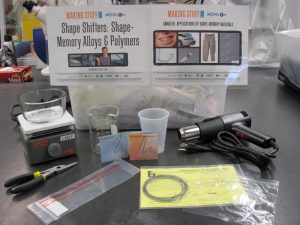Our kits are currently being reviewed and updated by a team of collaborative, innovative and interdisciplinary educators who wish to enhance the educational opportunities for students. These dedicated teachers are members of CRISP Collaborative Science for All (CCSA) as well as local educators.
Click to see the SCSU CRISP Module Template used by CCSA for improving and updating the CRISP demos and kits. Each kit page offers a CRISP developed teacher module and CRISP aligned standards (both NGSS and CCSS)
Kit Request form

All plastics are polymers, which are long chains of molecules. Shape-memory polymers, however, are combinations of two polymers, each of which has a different melting point. One polymer sets the permanent memorized shape at the polymer’s melting point while the other polymer creates the temporary shape at a different, transition temperature. Heat softens this temporary shape (by breaking the crosslinks between polymer strands), and the shape-memory polymer reverts to its permanent shape. Some shape-memory polymers have up to three memorized shapes, each triggered at a different temperature.
Adapted from Making Stuff Smarter by NOVA via the Making Stuff project
Subject(s):
Polymers, Smart Materials, Properties of Materials
Objectives:
Students should be able to:
- Explain how the chemical structure of polymers affects their physical properties.
- Explain the general formation and structure of carbon-based polymers, including synthetic polymers.
- Explain how simple chemical monomers can be combined to create linear, branched and/or cross-linked polymers.
- Observe the structure and function of everyday polymers.
Materials in this kit:
- Nitinol wires set straight
- ordinary wires – flexible (same length as Nitinol wire)
- clear container (to cool metal)
- heat gun
- samples of various plastics
- shape memory plastic strips
- paper towels
- safety goggles
- needle nose pliers
Suggestions for the Teacher:
Things to talk about:
- How can we design materials that respond to changes in their environment?
- How can we use those materials to make smarter stuff?
Safety:
- Have your students put on safety goggles.
- USE EXTREME CAUTION with the heat gun. DO NOT place heat gun on plastic or anything that can melt easily.
- DO NOT direct the heat gun at another person
- Allow metals to cool before touching them
Additional Resources:
Making Stuff Smarter Guide from NOVA
Making Stuff Website
Making Stuff Smarter
NOVA
STEM Careers:
Standards:
PS1 - Matter and Its Interactions
LS1 - From Molecules to Organisms: Structures and Processes
ETS1 - Engineering Design
ESS3 - Earth and Human Activity
Concept 2 - Cause and effect. Mechanism and explanation.
Concept 5 - Energy and matter: Flows, cycles, and conservation
Practice 2 - Developing and Using Models
Practice 3 - Planning and Carrying Out Investigations
Practice 8 - Obtaining, evaluating, and communicating information
Suggested Video(s):
http://www.pbs.org/wgbh/nova/tech/making-stuff.html#making-stuff-smarter
